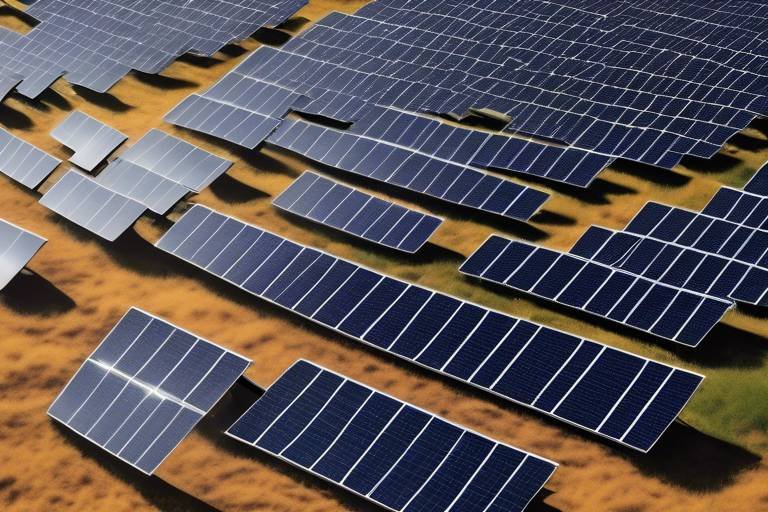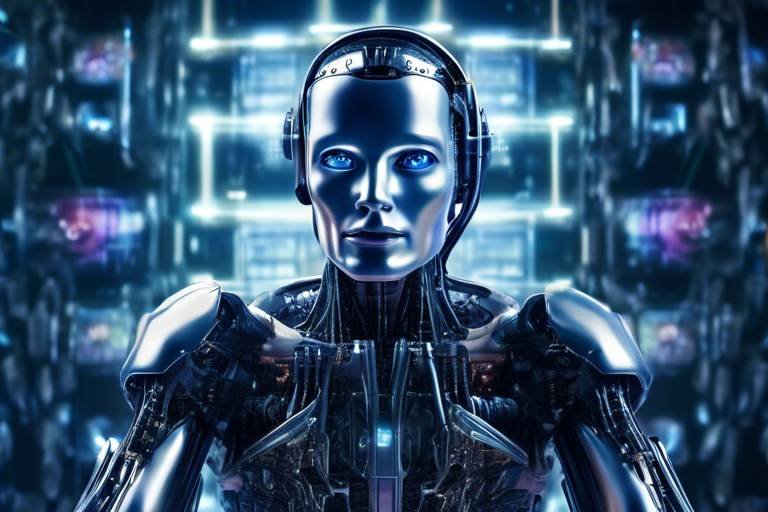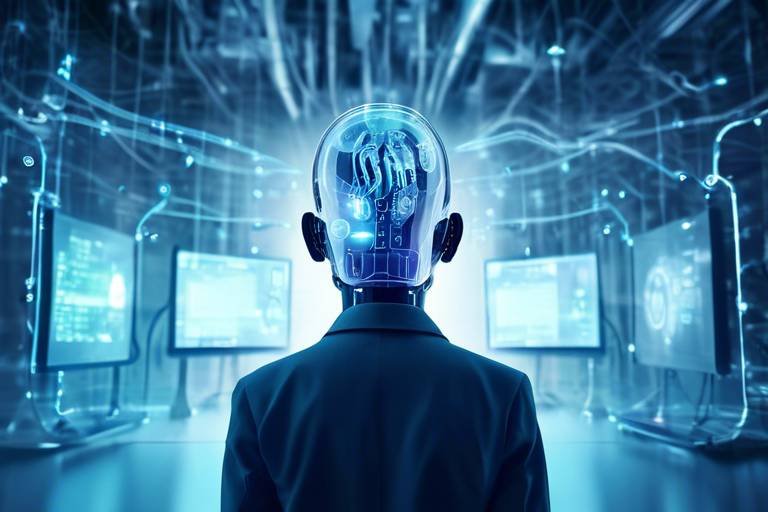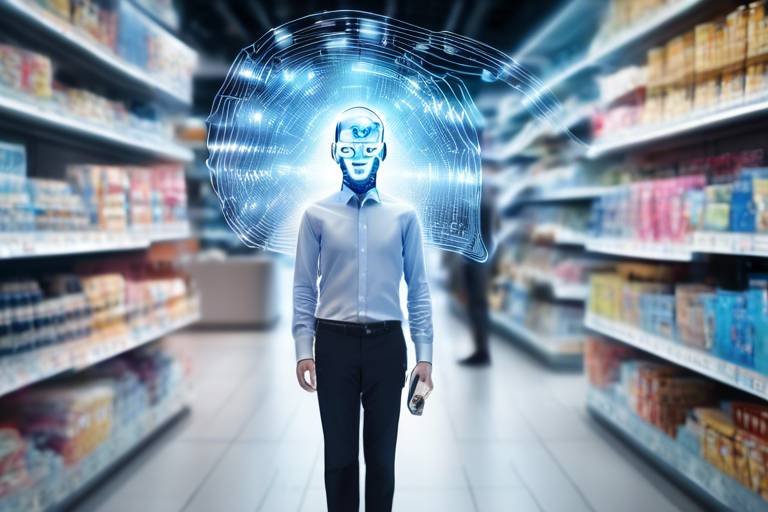The Role of AI in the Future of Solar Energy
The world is witnessing a significant shift towards renewable energy, and at the forefront of this revolution is solar energy. As we strive for a sustainable future, artificial intelligence (AI) is proving to be a game-changer in the solar energy sector. Imagine a world where solar panels not only generate energy but do so with maximum efficiency, minimal downtime, and optimal integration into our energy grids. This is not just a dream; it's becoming a reality thanks to AI technologies. By leveraging advanced algorithms and data analysis, AI is transforming how solar energy is produced, managed, and consumed.
In this article, we will explore the various ways AI is enhancing solar energy systems. From optimizing solar panel performance to predictive maintenance and smart grid integration, AI is paving the way for a more sustainable energy future. With AI's ability to analyze vast amounts of data, it can identify patterns and make informed decisions that lead to increased efficiency and reduced costs. So, how exactly does AI contribute to the solar energy landscape? Let’s dive deeper into this fascinating intersection of technology and sustainability.
One of the most exciting advancements in solar energy is the optimization of solar panels through AI technologies. By analyzing data from various sources, including weather patterns, solar radiation levels, and historical performance, AI can optimize the positioning and energy output of solar panels. This leads to a significant increase in efficiency and a reduction in costs associated with solar energy systems.
For instance, AI algorithms can determine the optimal tilt and orientation of solar panels based on real-time weather data. This means that solar panels can capture the maximum amount of sunlight throughout the day, leading to enhanced energy production. The result? More energy generated from the same number of panels, which translates into lower costs for consumers and businesses alike.
Another critical area where AI is making waves is in predictive maintenance for solar installations. Traditional maintenance practices often rely on scheduled inspections, which can lead to unnecessary downtime and increased operational costs. However, with AI, we can predict maintenance needs before issues arise, ensuring that solar systems operate at their best.
At the heart of this predictive maintenance capability are machine learning algorithms. These algorithms analyze historical performance data to identify patterns and predict potential failures. By recognizing signs of wear and tear or performance degradation, AI can alert operators to intervene before a complete breakdown occurs. This proactive approach enhances system reliability and minimizes unexpected outages, ultimately leading to a more sustainable energy solution.
To enable effective predictive maintenance, innovative data collection techniques are essential. Technologies such as IoT sensors can be deployed on solar panels to monitor their performance in real-time. These sensors gather valuable data, which feeds into machine learning models, allowing for continuous improvement of predictive maintenance strategies.
The benefits of predictive maintenance powered by AI are substantial. By minimizing downtime and ensuring timely interventions, we can achieve:
- Lower operational costs: Reducing the need for emergency repairs saves money.
- Extended equipment lifespan: Regular, data-driven maintenance prolongs the life of solar systems.
- Improved energy production: Consistent performance leads to higher energy output.
Together, these factors contribute to the overall sustainability of solar energy systems, making them more viable for the long term.
In addition to predictive maintenance, AI systems can monitor solar energy systems in real-time. This capability enables quick responses to performance issues, ensuring that energy production remains at optimal levels. For example, if a solar panel is underperforming due to shading or dirt accumulation, AI can alert operators to take corrective action immediately. This level of responsiveness is crucial in maximizing energy production, especially in regions where sunlight is inconsistent.
AI also plays a pivotal role in integrating solar energy into smart grids. By enhancing energy distribution, demand response, and grid stability, AI facilitates a more efficient energy ecosystem. Smart grids leverage AI's data analysis capabilities to manage energy flow effectively, balancing supply and demand in real-time.
One of the key components of smart grid integration is energy demand forecasting. AI models can analyze historical consumption data to predict future energy needs. This allows solar energy production to align more closely with consumer demand, improving grid efficiency and reliability.
Additionally, AI-driven load balancing solutions optimize energy distribution across the grid. By intelligently managing how and when solar energy is utilized, we can reduce reliance on fossil fuels and create a cleaner, more sustainable energy landscape.
Finally, AI is crucial in optimizing energy storage systems. With the ability to store solar energy for use during non-productive hours, AI enhances overall energy efficiency. By predicting charge and discharge cycles, AI algorithms improve battery management systems, maximizing battery lifespan and ensuring reliable energy availability.
These AI algorithms not only enhance performance but also contribute to the sustainability of energy storage solutions. As we integrate more renewable sources into our energy mix, the role of AI in managing these systems will only grow in importance.
Moreover, AI can facilitate the integration of solar energy with other renewable sources, creating a more resilient and sustainable energy ecosystem. By intelligently managing resources, we can ensure a stable energy supply that meets the needs of consumers while minimizing environmental impact.
Q: How does AI improve solar panel efficiency?
A: AI analyzes data to optimize the positioning and energy output of solar panels, leading to increased efficiency and reduced costs.
Q: What is predictive maintenance in solar energy?
A: Predictive maintenance uses AI to forecast maintenance needs, minimizing downtime and ensuring optimal performance through timely interventions.
Q: How does AI contribute to smart grid integration?
A: AI enhances energy distribution and demand response in smart grids, improving overall efficiency and reliability.

AI-Driven Solar Panel Optimization
In the ever-evolving landscape of renewable energy, stands out as a game-changer. Imagine a world where solar panels not only harness the sun's energy but do so with unprecedented efficiency. This is becoming a reality thanks to the integration of artificial intelligence technologies. By leveraging advanced algorithms and data analytics, AI is transforming how solar panels operate, ensuring they capture as much sunlight as possible while minimizing waste.
One of the most significant benefits of AI optimization is its ability to analyze vast amounts of data in real-time. This data can include weather patterns, historical energy output, and even the angle of sunlight throughout the day. With this information, AI systems can dynamically adjust the positioning of solar panels to maximize their exposure to sunlight. For instance, if a solar panel system is equipped with AI, it can tilt or rotate to follow the sun’s path, much like a sunflower turns to face the sun. This level of adaptability leads to a substantial increase in energy output.
Moreover, AI-driven optimization doesn’t just enhance performance; it also reduces costs. By increasing the efficiency of solar panels, less energy is wasted, which translates to lower operational costs. According to recent studies, AI-optimized solar systems can see efficiency improvements of up to 30% compared to traditional systems. This means that not only do these systems produce more energy, but they also do so at a lower cost, making solar energy more accessible than ever.
Another fascinating aspect of AI in solar panel optimization is its ability to predict energy output based on varying environmental conditions. For example, AI can forecast how much energy a solar panel will produce on a cloudy day versus a sunny day, allowing homeowners and businesses to plan their energy usage accordingly. This predictive capability can be crucial for managing energy needs and reducing reliance on the grid during peak demand times.
Furthermore, the integration of AI with Internet of Things (IoT) devices enhances the optimization process. IoT sensors can collect real-time data on solar panel performance, environmental conditions, and energy consumption. This data feeds into AI algorithms, which continuously learn and adapt to improve solar panel efficiency. The combination of AI and IoT creates a smart ecosystem where solar energy systems can operate autonomously, making adjustments without human intervention.
In summary, AI-driven solar panel optimization is revolutionizing the solar energy sector. With its ability to analyze data, predict energy output, and adjust panel positioning, AI is paving the way for a more efficient and cost-effective solar future. As we continue to embrace these technologies, we can expect to see even greater advancements that will further enhance the sustainability of solar energy solutions.

Predictive Maintenance with AI
In the ever-evolving landscape of solar energy, predictive maintenance powered by artificial intelligence (AI) is proving to be a game-changer. Imagine a world where solar panels operate at peak efficiency without the constant worry of unexpected failures. AI technology is stepping in to make that a reality by predicting maintenance needs before they become critical issues. This proactive approach minimizes downtime and ensures that solar installations are always performing at their best, which is essential for maximizing energy production.
So, how does this work? At the heart of predictive maintenance are machine learning algorithms that analyze historical performance data. These algorithms sift through mountains of data to identify patterns and predict potential failures. Think of it as having a crystal ball that not only tells you what might go wrong but also gives you the insights needed to fix it before it happens. By implementing such strategies, solar energy systems can achieve a level of reliability that was previously unattainable.
Machine learning is like a detective, piecing together clues from historical data to forecast future events. For solar installations, this means recognizing signs of wear and tear or identifying environmental factors that could affect performance. By leveraging these insights, solar operators can implement proactive maintenance strategies that significantly enhance system reliability. For instance, if a specific panel type consistently shows signs of degradation under certain conditions, operators can take action to mitigate those risks, ensuring that energy production remains stable and efficient.
But how do we gather the data necessary for these predictive models? Innovative data collection techniques, such as Internet of Things (IoT) sensors, are revolutionizing the way we monitor solar panels. These sensors provide real-time data on various performance metrics, including energy output, temperature, and even weather conditions. This wealth of information feeds into machine learning models, allowing them to make accurate predictions about maintenance needs. It's like having a health monitor for your solar panels, constantly checking their vitals and alerting you when something's off.
The benefits of implementing AI-driven predictive maintenance are profound. Not only does it result in lower operational costs by reducing the frequency of unexpected repairs, but it also extends the lifespan of equipment. When solar panels are maintained proactively, they can produce energy more efficiently over a longer period. This contributes to the overall sustainability of solar energy systems, making them not only a viable option but a smart choice for the future. In fact, studies have shown that predictive maintenance can increase energy production by up to 20%, a significant boost in an industry where efficiency is key.
In summary, predictive maintenance with AI is not just a trend; it is a fundamental shift in how we manage solar energy systems. By harnessing the power of data and machine learning, we can ensure that solar panels operate at their best, contributing to a cleaner, more sustainable energy future.
- What is predictive maintenance? Predictive maintenance uses data analysis tools and techniques to detect anomalies in equipment operation and possible defects in equipment before they result in failure.
- How does AI improve predictive maintenance? AI analyzes historical data to identify patterns and predict when maintenance should be performed, minimizing downtime and maintenance costs.
- What are the benefits of using AI in solar energy? AI enhances efficiency, reduces costs, improves reliability, and optimizes energy production in solar energy systems.
- Can predictive maintenance really extend the lifespan of solar panels? Yes, by addressing potential issues before they become serious problems, predictive maintenance can significantly extend the operational life of solar panels.

Machine Learning Algorithms
Machine learning algorithms are revolutionizing the solar energy landscape by providing powerful tools for analyzing vast amounts of data. These algorithms sift through historical performance data, identifying patterns that might escape the naked eye. Imagine having a super-smart assistant who can predict when your solar panels might need maintenance, all based on previous performance trends. This capability is not just a luxury; it's becoming essential in the quest for more efficient solar energy systems.
One of the most exciting aspects of machine learning in solar energy is its ability to enable proactive maintenance strategies. By analyzing data from solar installations, these algorithms can forecast potential failures before they happen. This means that instead of waiting for a problem to arise, solar energy providers can take action in advance, minimizing downtime and ensuring that systems operate at peak efficiency. For instance, if a machine learning model detects that a particular solar panel is underperforming relative to its historical data, it can alert technicians to investigate before a minor issue escalates into a significant failure.
To illustrate the impact of machine learning, consider the following table that summarizes the advantages of using these algorithms in solar energy systems:
| Benefits of Machine Learning Algorithms | Description |
|---|---|
| Predictive Analytics | Identifies potential failures and maintenance needs before they occur. |
| Enhanced Reliability | Improves system uptime and overall reliability through timely interventions. |
| Cost Efficiency | Reduces operational costs by minimizing unplanned maintenance and repairs. |
| Data-Driven Insights | Provides actionable insights that can improve energy production and efficiency. |
Moreover, the integration of Internet of Things (IoT) sensors with machine learning algorithms enhances real-time data collection. These sensors monitor various performance metrics, feeding valuable information back to the machine learning models. As a result, the algorithms can continuously learn and adapt, refining their predictions and strategies over time. This dynamic process ensures that solar energy systems are not just reactive but proactively managed, leading to a more sustainable energy future.
In summary, machine learning algorithms are not just a trend; they represent a fundamental shift in how we approach solar energy management. By harnessing the power of data and predictive analytics, these algorithms pave the way for more efficient, reliable, and cost-effective solar energy systems. The future looks bright for solar energy, and machine learning is helping to illuminate the path forward.
- What are machine learning algorithms?
Machine learning algorithms are computational methods that allow systems to learn from data and improve their performance over time without being explicitly programmed.
- How do these algorithms benefit solar energy systems?
They enhance predictive maintenance, improve system reliability, and reduce operational costs by analyzing data patterns and forecasting potential issues.
- Can machine learning operate in real-time?
Yes, when integrated with IoT sensors, machine learning can monitor solar systems in real-time, enabling immediate responses to performance issues.
- Are there any risks associated with machine learning in solar energy?
While machine learning offers many benefits, risks include reliance on data quality and the need for continuous updates to algorithms to adapt to changing conditions.

Data Collection Techniques
In the realm of solar energy, are the backbone of innovation and efficiency. With the advent of advanced technologies, the way we gather and analyze data has evolved dramatically. One of the most significant advancements is the use of Internet of Things (IoT) sensors. These tiny devices are strategically placed on solar panels to collect real-time data on various parameters such as temperature, sunlight intensity, and energy output. Imagine having a personal assistant for your solar panels, constantly monitoring their performance and alerting you to any issues. This is precisely what IoT sensors do, providing a wealth of information that can be analyzed to optimize energy production.
Moreover, the integration of machine learning algorithms with these data collection techniques allows for deeper insights. By analyzing historical data, machine learning models can identify patterns that might not be visible to the naked eye. For instance, if a particular solar panel consistently underperforms during specific weather conditions, the system can flag this for further investigation. This proactive approach not only enhances the efficiency of solar installations but also contributes to long-term sustainability.
Another innovative method involves the use of drones equipped with thermal imaging cameras. These drones can fly over solar farms to detect hotspots and irregularities that indicate potential failures. This method is not only faster than manual inspections but also provides a comprehensive view of the entire solar array. The data collected can then be analyzed to determine maintenance needs, ensuring that every panel is functioning at its best.
To summarize, the combination of IoT sensors, machine learning algorithms, and drone technology creates a robust framework for data collection in solar energy systems. These techniques not only improve operational efficiency but also pave the way for smarter, more sustainable energy solutions. The future of solar energy is bright, and with these advancements, we are just beginning to scratch the surface of what is possible.
- What are IoT sensors? - IoT sensors are devices that collect data from the environment and transmit it for analysis, helping to monitor solar panel performance in real-time.
- How do machine learning algorithms improve solar energy systems? - Machine learning algorithms analyze historical data to identify patterns, enabling proactive maintenance and optimization of energy production.
- What role do drones play in solar energy? - Drones equipped with thermal imaging can quickly inspect solar farms for hotspots and inefficiencies, providing valuable data for maintenance.

Benefits of Predictive Maintenance
This article explores how artificial intelligence is transforming the solar energy sector, improving efficiency, and paving the way for sustainable energy solutions in the future.
AI technologies are enhancing the performance of solar panels by analyzing data to optimize their positioning and energy output, leading to increased efficiency and reduced costs for solar energy systems.
Artificial intelligence can predict maintenance needs for solar installations, minimizing downtime and ensuring optimal performance through timely interventions and data-driven insights.
Machine learning algorithms analyze historical performance data to identify patterns and predict potential failures, allowing for proactive maintenance strategies that enhance system reliability.
Innovative data collection techniques, such as IoT sensors, enable real-time monitoring of solar panels, providing valuable insights for machine learning models to improve predictive maintenance.
Predictive maintenance, powered by artificial intelligence, offers a multitude of benefits that significantly enhance the efficiency and sustainability of solar energy systems. One of the primary advantages is the reduction in operational costs. By anticipating maintenance needs before they become critical issues, operators can avoid costly repairs and unplanned downtime. This proactive approach not only saves money but also ensures that the solar panels are functioning at peak performance.
Furthermore, predictive maintenance contributes to the extended lifespan of equipment. Regular, data-driven maintenance can help identify wear and tear early on, allowing for timely repairs that prevent more serious damage. This means that solar installations can operate longer, providing renewable energy over a more extended period without the need for frequent replacements.
Another significant benefit is the improvement in energy production. When solar panels are well-maintained and functioning efficiently, they generate more electricity. This increased output not only meets energy demands more effectively but also enhances the return on investment for solar energy systems. The table below illustrates the correlation between predictive maintenance practices and energy production efficiency:
| Maintenance Approach | Energy Production Efficiency (%) |
|---|---|
| Reactive Maintenance | 70 |
| Preventive Maintenance | 85 |
| Predictive Maintenance | 95 |
In addition to these advantages, predictive maintenance also enhances the overall sustainability of solar energy systems. By ensuring that solar panels operate efficiently, we reduce the need for backup energy sources, which are often fossil fuel-based. This shift not only lowers greenhouse gas emissions but also promotes a cleaner, more sustainable energy landscape.
In summary, the benefits of predictive maintenance are clear: lower operational costs, extended equipment lifespan, improved energy production, and enhanced sustainability. As we continue to embrace AI technologies in the solar energy sector, these advantages will play a crucial role in our transition to a more sustainable future.
AI systems can monitor solar energy systems in real-time, enabling quick responses to performance issues and ensuring that energy production remains at optimal levels.
AI facilitates the integration of solar energy into smart grids, enhancing energy distribution, demand response, and grid stability through intelligent data analysis and management.
AI models can forecast energy demand patterns, allowing for better alignment of solar energy production with consumption needs, thus improving grid efficiency and reliability.
AI-driven load balancing solutions optimize energy distribution across the grid, ensuring that solar energy is utilized effectively and reducing reliance on fossil fuels.
Artificial intelligence plays a crucial role in optimizing energy storage systems, enabling better management of solar energy for use during non-productive hours and enhancing overall energy efficiency.
AI algorithms improve battery management systems by predicting charge and discharge cycles, maximizing battery lifespan, and ensuring reliable energy availability.
AI can facilitate the integration of solar energy with other renewable sources, creating a more resilient and sustainable energy ecosystem through intelligent resource management.
- How does AI improve solar panel efficiency? AI analyzes data to optimize the positioning and energy output of solar panels, leading to greater efficiency.
- What is predictive maintenance in solar energy? Predictive maintenance uses AI to anticipate maintenance needs, minimizing downtime and enhancing performance.
- What are the benefits of using AI in energy storage systems? AI optimizes battery management, predicts charge cycles, and ensures reliable energy availability.

Real-Time Performance Monitoring
Imagine having a personal assistant that never sleeps, constantly keeping an eye on your solar energy system. That's what powered by artificial intelligence (AI) offers. This technology is like having a hawk's eye on your solar panels, ensuring that everything is functioning at peak efficiency. By utilizing advanced algorithms and data analytics, AI systems can monitor various parameters of solar installations in real time, allowing for immediate action when issues arise.
For instance, if a solar panel starts underperforming due to shading or dirt accumulation, AI can detect this anomaly almost instantly. This capability is crucial because even a small drop in performance can significantly impact energy production over time. By identifying these problems early, operators can take corrective measures, such as repositioning panels or scheduling cleaning, before they lead to larger issues. The result? Increased energy output and reduced operational costs.
Furthermore, real-time monitoring systems can provide detailed insights into energy production patterns, helping stakeholders understand how different factors affect efficiency. For example, a real-time dashboard can display:
| Parameter | Current Value | Optimal Value |
|---|---|---|
| Energy Production (kWh) | 250 | 300 |
| Panel Temperature (°C) | 45 | 40 |
| Shading Percentage (%) | 10 | 0 |
This table not only highlights the current performance but also sets benchmarks for optimal performance, allowing operators to make informed decisions. By analyzing this data, AI can suggest adjustments to maximize efficiency. Think of it as a coach guiding an athlete to break personal records; the insights gained from real-time data can lead to significant improvements in performance.
Moreover, the integration of IoT sensors enhances the real-time monitoring experience. These sensors collect data on various environmental conditions, such as sunlight intensity and temperature, feeding this information back to the AI system. The AI can then correlate this data with energy output, creating a comprehensive understanding of how external factors influence performance. This relationship is vital for optimizing energy production, especially in regions with fluctuating weather patterns.
In summary, real-time performance monitoring is a game-changer in the solar energy sector. By leveraging AI technologies, solar operators can ensure that their systems are not just running but thriving. This proactive approach not only boosts energy production but also contributes to the sustainability goals of solar energy as a whole. As we look to the future, the importance of such monitoring systems will only grow, paving the way for smarter and more efficient energy solutions.
- What is real-time performance monitoring?
Real-time performance monitoring refers to the continuous observation of solar energy systems using AI technologies to ensure optimal performance and immediate detection of issues. - How does AI improve solar energy efficiency?
AI improves efficiency by analyzing data to optimize solar panel positioning, predict maintenance needs, and monitor performance in real-time. - What role do IoT sensors play in solar energy?
IoT sensors collect environmental data that helps AI systems analyze performance and make informed decisions for optimizing energy production.

Smart Grid Integration
As we move toward a more sustainable future, the integration of solar energy into smart grids emerges as a pivotal development. AI acts as the brain behind this transformation, making it possible to analyze vast amounts of data in real-time, which is crucial for enhancing energy distribution and grid stability. Imagine a conductor leading an orchestra—AI ensures that all components of the energy system work harmoniously together, creating a symphony of efficiency and reliability.
One of the most exciting aspects of smart grid integration is its ability to facilitate demand response. This means that when energy demand spikes, the smart grid can quickly adjust, redirecting solar energy where it’s needed most. For instance, during peak hours, AI can manage the distribution of energy to homes and businesses, ensuring that the solar energy produced is utilized effectively. This not only helps in optimizing energy use but also reduces the reliance on traditional fossil fuels, which is a significant step toward a greener planet.
Furthermore, AI enhances grid stability by predicting fluctuations in energy supply and demand. Through sophisticated algorithms, AI can analyze historical data, weather patterns, and consumption trends to forecast when energy demand will peak. This capability allows energy providers to prepare in advance, ensuring that the grid remains balanced and operational. The result? Fewer blackouts and a more reliable power supply for everyone.
To illustrate the impact of AI on smart grid integration, consider the following table that outlines key benefits:
| Benefit | Description |
|---|---|
| Enhanced Efficiency | AI optimizes energy distribution, ensuring that solar energy is used effectively. |
| Improved Reliability | Real-time monitoring allows for quick responses to potential issues, maintaining grid stability. |
| Reduced Costs | Smart grid integration lowers operational costs by minimizing energy wastage. |
| Environmental Impact | By reducing reliance on fossil fuels, AI-driven smart grids contribute to a more sustainable future. |
In addition, AI can implement load balancing solutions that ensure energy is distributed evenly across the grid. This means that no single part of the grid is overwhelmed while others are underutilized. By using AI to analyze real-time data, energy providers can allocate resources dynamically, making sure that every kilowatt of solar energy is put to good use.
In conclusion, the integration of AI with smart grids is not just a technological advancement; it is a game changer for the solar energy sector. It paves the way for a more resilient and sustainable energy ecosystem, where solar energy can thrive alongside other renewable sources. By leveraging AI, we are not merely adapting to the future of energy; we are actively shaping it.
- What is a smart grid? A smart grid is an electrical grid that uses digital technology to monitor and manage the transport of electricity from all generation sources to meet the varying electricity demands of end users.
- How does AI improve solar energy efficiency? AI analyzes data to optimize solar panel positioning and energy output, leading to increased efficiency and reduced costs.
- What role does AI play in predictive maintenance? AI predicts maintenance needs for solar installations by analyzing historical performance data, minimizing downtime and ensuring optimal performance.
- Can AI help in energy demand forecasting? Yes! AI models can forecast energy demand patterns, allowing for better alignment of solar energy production with consumption needs.

Energy Demand Forecasting
Energy demand forecasting is like peering into a crystal ball that reveals how much energy we will need in the future. With the rise of artificial intelligence, this process has become more precise and reliable than ever before. Imagine trying to predict the weather but instead of rain or sunshine, you’re forecasting energy needs. AI models analyze a plethora of data points, from historical energy consumption patterns to real-time weather conditions, ensuring that we can align solar energy production with actual demand.
This predictive capability is crucial for optimizing energy resources. For instance, during hot summer days, when air conditioning usage spikes, AI can forecast the increased demand and adjust solar energy production accordingly. This ensures that the energy supplied is not just adequate but also sustainable. By leveraging advanced algorithms, AI can identify trends and anomalies in energy consumption, which allows energy providers to make informed decisions about energy distribution.
Furthermore, the integration of AI into energy demand forecasting involves several sophisticated techniques. For example, machine learning algorithms can analyze seasonal variations, economic indicators, and even social media trends to predict energy usage. This multifaceted approach means that energy providers can not only react to current demands but also anticipate future needs, leading to a more efficient energy grid.
To illustrate the impact of accurate energy demand forecasting, consider the following table:
| Forecasting Method | Accuracy Rate | Benefits |
|---|---|---|
| Traditional Methods | 60-70% | Basic trend analysis, limited data |
| AI-Driven Forecasting | 85-95% | Real-time data integration, high precision |
As you can see, the difference in accuracy between traditional methods and AI-driven forecasting is significant. By utilizing AI, energy companies can not only improve their forecasting accuracy but also enhance their operational efficiency. This leads to reduced energy waste and better resource management, which is essential for the sustainability of solar energy systems.
In conclusion, energy demand forecasting powered by AI is not just a technological advancement; it’s a necessary evolution in how we approach energy management. By accurately predicting demand, we can make better use of solar energy, ensuring that it meets the needs of consumers while also contributing to a greener planet.
- What is energy demand forecasting? Energy demand forecasting is the process of predicting future energy needs based on various data inputs.
- How does AI improve energy demand forecasting? AI enhances forecasting accuracy by analyzing vast amounts of data and identifying patterns that traditional methods may miss.
- Why is accurate forecasting important for solar energy? Accurate forecasting ensures that solar energy production aligns with consumer demand, reducing waste and improving efficiency.

Load Balancing Solutions
In the dynamic landscape of energy distribution, powered by artificial intelligence are becoming increasingly vital. Imagine a bustling city where the lights flicker in and out, not due to a lack of energy but because of inefficient distribution. This is where AI steps in, ensuring that solar energy is utilized effectively across the grid. By analyzing real-time data, AI can predict energy consumption patterns and adjust the distribution of solar power accordingly, much like a skilled conductor leading an orchestra to create a harmonious symphony of energy flow.
One of the most significant challenges in solar energy distribution is the intermittent nature of sunlight. During peak sunlight hours, solar panels produce a surplus of energy, which can lead to grid congestion if not managed properly. Conversely, during cloudy days or at night, energy production drops significantly. AI-driven load balancing solutions tackle this issue head-on by implementing smart algorithms that assess both energy production and consumption in real-time. This allows for a more responsive energy distribution system that can adapt to changing conditions.
For instance, AI can optimize the use of energy storage systems by determining when to store excess energy and when to release it back into the grid. This not only maximizes the efficiency of solar energy use but also reduces reliance on fossil fuels, contributing to a more sustainable energy ecosystem. Additionally, these solutions can help in reducing energy costs for consumers by minimizing peak demand charges and ensuring that energy is available when it's needed the most.
To illustrate the impact of AI in load balancing, consider the following table that outlines the benefits of implementing AI-driven solutions in solar energy distribution:
| Benefit | Description |
|---|---|
| Increased Efficiency | AI optimizes energy distribution based on real-time consumption data, reducing waste. |
| Cost Reduction | Minimizes peak demand charges and lowers overall energy costs for consumers. |
| Enhanced Reliability | Ensures that energy supply meets demand, reducing the risk of outages. |
| Environmental Impact | Reduces reliance on fossil fuels, promoting a cleaner energy future. |
As we move towards a more sustainable future, the integration of AI in load balancing solutions will be crucial. By ensuring that solar energy is distributed efficiently and effectively, we can create a resilient energy grid that not only meets the demands of today but is also prepared for the challenges of tomorrow. The journey towards a greener planet is not just about generating renewable energy; it's about managing it wisely, and AI is leading the charge.
- What is load balancing in energy distribution?
Load balancing refers to the distribution of energy across the grid to ensure that supply meets demand, preventing outages and optimizing efficiency.
- How does AI improve load balancing?
AI analyzes real-time data on energy production and consumption, allowing for dynamic adjustments in energy distribution to maximize efficiency and reliability.
- What are the benefits of AI-driven load balancing solutions?
Benefits include increased efficiency, reduced costs, enhanced reliability, and a positive environmental impact by minimizing fossil fuel reliance.

Enhancing Energy Storage Systems
In the ever-evolving landscape of solar energy, artificial intelligence (AI) is proving to be a game-changer, particularly in the realm of energy storage systems. As solar energy generation can be intermittent—producing energy only when the sun shines—efficient storage solutions are essential for maximizing the use of this renewable resource. AI algorithms are stepping in to optimize these systems, ensuring that solar energy can be harnessed and utilized effectively, even during non-productive hours.
One of the most significant advancements in energy storage comes from the integration of AI algorithms into battery management systems. These systems monitor and predict the charge and discharge cycles of batteries, allowing for better management of energy flow. By analyzing historical data and real-time inputs, AI can forecast when energy demand will peak and when it will dip, helping to ensure that stored energy is available when it's needed most. This predictive capability not only maximizes the lifespan of batteries but also enhances the reliability of energy availability.
Moreover, AI's ability to analyze vast amounts of data in real-time allows for the optimization of energy storage across multiple sources. For instance, when solar energy is combined with other renewable resources like wind or hydro, AI can manage the flow of energy between these sources to create a more resilient and sustainable energy ecosystem. This intelligent resource management ensures that energy is used efficiently, reducing waste and reliance on fossil fuels.
To illustrate the impact of AI on energy storage systems, consider the following table that outlines key benefits:
| Benefit | Description |
|---|---|
| Optimized Battery Lifespan | AI predicts charge cycles, reducing wear and tear on batteries. |
| Enhanced Energy Availability | Ensures energy is available during peak demand times through smart management. |
| Increased Efficiency | Minimizes energy waste by aligning production with consumption needs. |
| Integration of Multiple Sources | Facilitates seamless energy flow between solar and other renewable sources. |
In addition to these benefits, AI-driven energy storage solutions can also contribute to the overall sustainability of solar energy systems. By enabling better energy management, they help reduce greenhouse gas emissions and promote a cleaner energy future. As we move towards a world increasingly reliant on renewable energy, the role of AI in enhancing energy storage systems will become even more critical.
- How does AI improve battery management systems?
AI improves battery management by predicting charge and discharge cycles, optimizing performance, and extending battery life. - Can AI integrate solar energy with other renewable sources?
Yes, AI facilitates the integration of solar energy with other sources like wind and hydro, optimizing energy distribution. - What are the environmental benefits of AI in energy storage?
AI helps reduce waste, enhances efficiency, and lowers greenhouse gas emissions, contributing to a sustainable energy future.

Battery Management Systems
In the realm of solar energy, Battery Management Systems (BMS) are the unsung heroes that ensure our energy storage solutions operate at peak performance. Imagine a conductor leading an orchestra—without them, the music would be chaotic, and the same goes for energy storage without a BMS. These systems monitor and control the charging and discharging of batteries, optimizing their performance and longevity. By leveraging artificial intelligence, BMS can predict the best times to charge or discharge, ensuring that energy is available exactly when it's needed.
One of the most remarkable benefits of AI in BMS is its ability to analyze vast amounts of data in real-time. This analysis helps in identifying patterns in energy consumption and production, which can significantly enhance the efficiency of solar energy systems. For instance, if a household uses more energy during the evening, the BMS can adjust the battery's charge cycles accordingly, storing energy from the day for use at night. This not only maximizes energy availability but also reduces reliance on the grid, making solar systems more sustainable.
To illustrate how a BMS operates, consider the following table that outlines the key functions of a typical Battery Management System:
| Function | Description |
|---|---|
| Voltage Monitoring | Ensures each cell in the battery pack operates within safe voltage limits. |
| Temperature Control | Monitors battery temperature to prevent overheating and optimize performance. |
| State of Charge (SoC) Estimation | Calculates the current charge level of the battery to inform usage decisions. |
| Cycle Management | Tracks charge and discharge cycles to extend battery lifespan. |
Moreover, the integration of AI into BMS allows for predictive analytics, which is crucial for maintaining battery health. By utilizing machine learning algorithms, these systems can forecast potential issues before they arise. For example, if a battery shows signs of degradation, the BMS can recommend maintenance or adjustments to prevent failures. This proactive approach not only enhances reliability but also saves costs associated with unexpected outages or replacements.
In conclusion, Battery Management Systems are vital for the efficiency and sustainability of solar energy solutions. With the infusion of AI technologies, these systems are becoming smarter, more responsive, and ultimately more capable of meeting our energy needs. As we continue to embrace renewable energy, the role of BMS will only grow in importance, ensuring that we harness the sun’s power effectively and responsibly.
- What is a Battery Management System?
A BMS is a system that monitors and manages a battery's performance, ensuring its safety and longevity. - How does AI improve Battery Management Systems?
AI enhances BMS by predicting optimal charge cycles and identifying potential issues before they occur. - Why is predictive maintenance important in solar energy?
Predictive maintenance helps in minimizing downtime and maximizing energy production, leading to cost savings. - Can BMS integrate with other renewable energy sources?
Yes, BMS can work alongside other renewable sources to create a more efficient energy ecosystem.

Integration with Renewable Sources
This article explores how artificial intelligence is transforming the solar energy sector, improving efficiency, and paving the way for sustainable energy solutions in the future.
AI technologies are enhancing the performance of solar panels by analyzing data to optimize their positioning and energy output, leading to increased efficiency and reduced costs for solar energy systems.
Artificial intelligence can predict maintenance needs for solar installations, minimizing downtime and ensuring optimal performance through timely interventions and data-driven insights.
Machine learning algorithms analyze historical performance data to identify patterns and predict potential failures, allowing for proactive maintenance strategies that enhance system reliability.
Innovative data collection techniques, such as IoT sensors, enable real-time monitoring of solar panels, providing valuable insights for machine learning models to improve predictive maintenance.
Predictive maintenance powered by AI results in lower operational costs, extended equipment lifespan, and improved energy production, contributing to the overall sustainability of solar energy systems.
AI systems can monitor solar energy systems in real-time, enabling quick responses to performance issues and ensuring that energy production remains at optimal levels.
AI facilitates the integration of solar energy into smart grids, enhancing energy distribution, demand response, and grid stability through intelligent data analysis and management.
AI models can forecast energy demand patterns, allowing for better alignment of solar energy production with consumption needs, thus improving grid efficiency and reliability.
AI-driven load balancing solutions optimize energy distribution across the grid, ensuring that solar energy is utilized effectively and reducing reliance on fossil fuels.
Artificial intelligence plays a crucial role in optimizing energy storage systems, enabling better management of solar energy for use during non-productive hours and enhancing overall energy efficiency.
AI algorithms improve battery management systems by predicting charge and discharge cycles, maximizing battery lifespan, and ensuring reliable energy availability.
As we venture into a future powered by clean energy, the integration of solar energy with other renewable sources becomes increasingly vital. Imagine a symphony where each instrument plays its part in harmony; this is akin to how different renewable energy sources, like wind, hydro, and solar, can work together to create a robust energy ecosystem. By leveraging artificial intelligence, we can enhance this integration, ensuring that energy production is not only efficient but also reliable.
AI facilitates this integration by analyzing data from various sources, allowing for real-time adjustments and optimizations. For instance, when solar energy production dips during cloudy days, AI can adjust the energy supply from wind or hydro sources to maintain a steady flow of electricity. This dynamic management is crucial for meeting the ever-changing energy demands of modern society.
Moreover, AI can help in forecasting energy availability from different sources, enabling better planning and resource allocation. By predicting when solar energy will be abundant or when wind energy will peak, energy providers can make informed decisions on how to distribute power effectively. This is not just about efficiency; it's about creating a sustainable future where our energy needs are met without compromising the environment.
One of the exciting developments in this area is the use of smart grids that utilize AI for real-time monitoring and management. These grids can balance the load between different renewable sources, ensuring that energy is used optimally and waste is minimized. The result is a more resilient energy infrastructure that can adapt to fluctuations in supply and demand.
In summary, the integration of solar energy with other renewable sources, powered by AI, is not just a trend; it is a necessary evolution towards a sustainable energy future. As we harness the power of multiple energy sources, we pave the way for a cleaner, greener planet.
- What is the role of AI in solar energy? AI enhances solar energy efficiency through optimization, predictive maintenance, and integration with other renewable sources.
- How does AI improve solar panel performance? AI analyzes data to optimize the positioning and energy output of solar panels, leading to increased efficiency.
- Can AI predict maintenance needs for solar installations? Yes, AI uses historical data to predict maintenance needs, minimizing downtime and ensuring optimal performance.
- What are smart grids? Smart grids use AI to manage energy distribution from various sources, improving reliability and efficiency.
Frequently Asked Questions
- How does AI improve solar panel efficiency?
AI enhances solar panel efficiency by analyzing data to optimize their positioning and energy output. This means that the panels can be adjusted in real-time to capture the maximum sunlight, ultimately leading to increased energy production and reduced costs for solar energy systems.
- What is predictive maintenance in solar energy?
Predictive maintenance uses AI to forecast when maintenance is needed for solar installations. By analyzing historical performance data, AI can identify patterns and predict potential failures, which helps in scheduling timely interventions that minimize downtime and ensure optimal performance.
- How do machine learning algorithms contribute to solar energy?
Machine learning algorithms analyze vast amounts of data collected from solar panels to identify performance trends. This allows for proactive maintenance strategies that enhance system reliability, ensuring that the solar panels operate efficiently and effectively over time.
- What role do IoT sensors play in solar energy?
IoT sensors are crucial for real-time monitoring of solar panels. They collect valuable data that feeds into machine learning models, enabling better predictive maintenance and performance optimization, which ultimately leads to enhanced energy production and system longevity.
- How does AI facilitate smart grid integration?
AI plays a vital role in integrating solar energy into smart grids by analyzing data to enhance energy distribution and manage demand response. This ensures grid stability and efficiency, allowing solar energy to be used more effectively across the network.
- Can AI forecast energy demand?
Absolutely! AI models can forecast energy demand patterns, which helps align solar energy production with actual consumption needs. This forecasting capability improves grid reliability and ensures that energy is available when it’s needed most.
- What are load balancing solutions in the context of solar energy?
AI-driven load balancing solutions optimize the distribution of energy across the grid. This means that when solar energy is abundant, it can be effectively utilized, reducing reliance on fossil fuels and enhancing overall energy sustainability.
- How does AI optimize energy storage systems?
AI optimizes energy storage systems by predicting charge and discharge cycles for batteries. This ensures that energy is stored efficiently for use during non-productive hours, maximizing battery lifespan and guaranteeing reliable energy availability.
- Can AI integrate solar energy with other renewable sources?
Yes! AI facilitates the integration of solar energy with other renewable sources, creating a more resilient and sustainable energy ecosystem. By intelligently managing resources, AI helps ensure that all available renewable energy sources work together harmoniously.



















